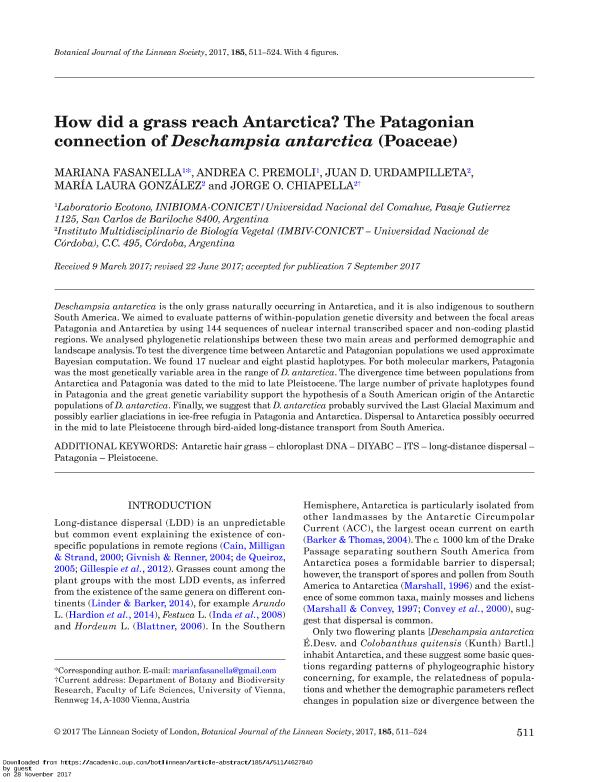Artículo
How did a grass reach Antarctica? The Patagonian connection of Deschampsia antarctica (Poaceae)
Fasanella, Mariana ; Premoli Il'grande, Andrea Cecilia
; Premoli Il'grande, Andrea Cecilia ; Urdampilleta, Juan Domingo
; Urdampilleta, Juan Domingo ; González, María Laura
; González, María Laura ; Chiapella, Jorge Oscar
; Chiapella, Jorge Oscar
 ; Premoli Il'grande, Andrea Cecilia
; Premoli Il'grande, Andrea Cecilia ; Urdampilleta, Juan Domingo
; Urdampilleta, Juan Domingo ; González, María Laura
; González, María Laura ; Chiapella, Jorge Oscar
; Chiapella, Jorge Oscar
Fecha de publicación:
11/2017
Editorial:
Oxford University Press
Revista:
Botanical Journal of The Linnean Society
ISSN:
0024-4074
Idioma:
Inglés
Tipo de recurso:
Artículo publicado
Clasificación temática:
Resumen
Deschampsia antarctica is the only grass naturally occurring in Antarctica, and it is also indigenous to southern South America. We aimed to evaluate patterns of within-population genetic diversity and between the focal areas Patagonia and Antarctica by using 144 sequences of nuclear internal transcribed spacer and non-coding plastid regions. We analysed phylogenetic relationships between these two main areas and performed demographic and landscape analysis. To test the divergence time between Antarctic and Patagonian populations we used approximate Bayesian computation. We found 17 nuclear and eight plastid haplotypes. For both molecular markers, Patagonia was the most genetically variable area in the range of D. antarctica. The divergence time between populations from Antarctica and Patagonia was dated to the mid to late Pleistocene. The large number of private haplotypes found in Patagonia and the great genetic variability support the hypothesis of a South American origin of the Antarctic populations of D. antarctica. Finally, we suggest that D. antarctica probably survived the Last Glacial Maximum and possibly earlier glaciations in ice-free refugia in Patagonia and Antarctica. Dispersal to Antarctica possibly occurred in the mid to late Pleistocene through bird-aided long-distance transport from South America.
Archivos asociados
Licencia
Identificadores
Colecciones
Articulos(IMBIV)
Articulos de INST.MULTIDISCIPL.DE BIOLOGIA VEGETAL (P)
Articulos de INST.MULTIDISCIPL.DE BIOLOGIA VEGETAL (P)
Articulos(INIBIOMA)
Articulos de INST. DE INVEST.EN BIODIVERSIDAD Y MEDIOAMBIENTE
Articulos de INST. DE INVEST.EN BIODIVERSIDAD Y MEDIOAMBIENTE
Citación
Fasanella, Mariana; Premoli Il'grande, Andrea Cecilia; Urdampilleta, Juan Domingo; González, María Laura; Chiapella, Jorge Oscar; How did a grass reach Antarctica? The Patagonian connection of Deschampsia antarctica (Poaceae); Oxford University Press; Botanical Journal of The Linnean Society; 185; 4; 11-2017; 511-524
Compartir
Altmétricas



